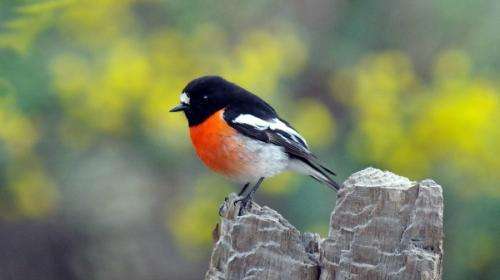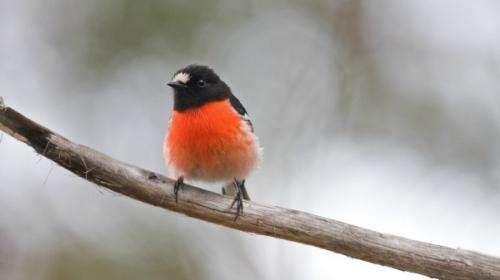Single gene points to separate bird species

The scarlet robin (Petroica boodang) may be classified into separate eastern and western Australian species following thousands of years of evolution separated by natural geographical barriers including the Nullarbor Plain.
WA Museum geneticist Gaynor Dolman, who studied a dozen accepted species, says the robin is one of several southern Australian birds whose populations have been separated by natural barriers for so long they have become distinct species.
These include the chestnut quail-thrush (Cinclosoma castanotum), white-naped honeyeater (Melithreptus lunatus), New Holland honeyeater (Phylidonyris novaehollandiae) and white-eared honeyeater (Nesoptilotis leucotis).
Dr Dolman says several natural geographical barriers appear to have prevented populations from mixing at different times.
She says the most permanent and significant of these is the "Eyrean Barrier" consisting of the Flinders Ranges and the salty Lake Eyre Basin in South Australia, which has kept some populations separate for at least 600,000 years.
She attributes the oldest species divergence, perhaps 1.5 million years ago, to this barrier.
Dr Dolman says the Nullarbor Plain had been in the landscape for a long time and potentially affects the birds.
"But they also might be able to get past the Nullarbor at different periods where there's more drainage in the system or the shoreline is further back," she says

Dr Dolman the Nullarbor may have led to a later species divergence about 275,000 years ago in some cases, and there may have been a more recent divergence that is yet to be confirmed.
She says she had access to only one specimen of a scarlet-breasted robin collected west of the Eyrean Barrier and west of the Nullarbor.
In cases like this she says she cannot decide whether the Nullarbor or Eyrean barriers caused the species to separate.
She came to these conclusions after comparing a gene she extracted from birds in collections in the CSIRO's Australian National Wildlife Collection in Canberra, and the Western Australian and South Australian Museums.

"It's quite a long stretch of DNA and allows us to look at relationships between individuals and species quite nicely," she says.
"So this study's based on one single mitochondrial DNA link and then putting that together with the birds' dietary ecology and habitat and then taxonomy to try and look at their history."
Beside natural barriers, she says the emerging arid zone that developed as damper forests receded to southeastern and southwestern Australia provided opportunities for new sub-species more suited to desert and mallee ecologies to develop.
More information: "Evolutionary history of birds across southern Australia: structure, history and taxonomic implications of mitochondrial DNA diversity in an ecologically diverse suite of species." Emu 2015, 115, 35–48 CSIRO Publishing, dx.doi.org/10.1071/MU14047
Provided by Science Network WA




















